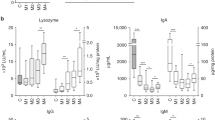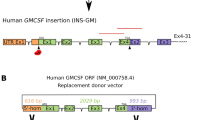Abstract
Mastitis, the most consequential disease in dairy cattle, costs the US dairy industry billions of dollars annually. To test the feasibility of protecting animals through genetic engineering, transgenic cows secreting lysostaphin at concentrations ranging from 0.9 to 14 mg/ml in their milk were produced. In vitro assays demonstrated the milk's ability to kill Staphylococcus aureus. Intramammary infusions of S. aureus were administered to three transgenic and ten nontransgenic cows. Increases in milk somatic cells, elevated body temperatures and induced acute phase proteins, each indicative of infection, were observed in all of the nontransgenic cows but in none of the transgenic animals. Protection against S. aureus mastitis appears to be achievable with as little as 3 mg/ml of lysostaphin in milk. Our results indicate that genetic engineering can provide a viable tool for enhancing resistance to disease and improve the well-being of livestock.
This is a preview of subscription content, access via your institution
Access options
Subscribe to this journal
Receive 12 print issues and online access
$209.00 per year
only $17.42 per issue
Buy this article
- Purchase on Springer Link
- Instant access to full article PDF
Prices may be subject to local taxes which are calculated during checkout




Similar content being viewed by others
Change history
01 July 2005
Nat. Biotechnol. 23, 445–451 (2005) In the abstract on page 445, the quantities given for lysostaphin in the following sentences are incorrect: “To test the feasibility of protecting animals through genetic engineering, transgenic cows secreting lysostaphin at concentrations ranging from 0.9 to 14 mg/ml in their milk were produced” and “Protection against S.
References
Hammer, R.E. et al. Production of transgenic rabbits, sheep and pigs by microinjection. Nature 315, 680–683 (1985).
Krimpenfort, P. et al. Generation of transgenic dairy cattle using in vitro embryo production. Bio/Technology 9, 844–847 (1991).
Wright, G. et al. High level expression of active human α-1-antitrypsin in the milk of transgenic sheep. Bio/Technology 9, 830–834 (1991).
Velander, W.H. et al. High-level expression of a heterologous protein in the milk of transgenic swine using the cDNA encoding human protein C. Proc. Natl. Acad. Sci. USA 89, 12003–12007 (1992).
Ebert, K.M. et al. Transgenic production of a variant of human tissue-type plasminogen activator in goat milk: generation of transgenic goats and analysis of expression. Bio/Technology 9, 835–838 (1991).
Swanson, M.E. et al. Production of functional human hemoglobin in transgenic swine. Bio/Technology 10, 557–559 (1992).
Fodor, W.L. et al. Expression of a functional human complement inhibitor in a transgenic pig as a model for the prevention of xenogeneic hyperacute organ rejection. Proc. Natl. Acad. Sci. USA 91, 11153–11157 (1994).
Bleck, G.T., White, B.R., Miller, D.J. & Wheeler, M.B. Production of bovine α-lactalbumin in the milk of transgenic pigs. J. Anim. Sci. 76, 3072–3078 (1998).
Brophy, B. et al. Cloned transgenic cattle produce milk with higher levels of β-casein and κ-casein. Nat. Biotechnol. 21, 157–162 (2003).
Pursel, V.G. et al. Growth and tissue accretion rates of swine expressing an insulin-like growth factor 1 transgene. Anim. Biotechnol. 15, 33–45 (2004).
Reh, W.A. et al. Hot topic: using a stearoyl-CoA desaturase transgene to alter milk fatty acid composition. J. Dairy Sci. 87, 3510–3514 (2004).
Saeki, K. et al. Functional expression of a Delta12 fatty acid desaturase gene from spinach in transgenic pigs. Proc. Natl. Acad. Sci. USA 101, 6361–6366 (2004).
Crittenden, L.B. & Salter, D.W. Gene insertion: current progress and long-term goals. Avian Dis. 30, 43–46 (1986).
Clements, J.E. et al. Development of transgenic sheep that express the visna virus envelope gene. Virology 200, 370–380 (1994).
Sordillo, L.M. & Streicher, K.L. Mammary gland immunity and mastitis susceptibility. J. Mammary Gland Biol. Neoplasia 7, 135–146 (2002).
Jasper, D.E. et al. Bovine mastitis research. Needs, funding and sources of support. in Proceedings of the 21st Annual Meeting of the National Mastitis Council, 182–193, (National Mastitis Council, Washington, DC, 1982).
Esslemont, D. & Kossaibati, M. Mastitis: how to get out of the dark ages. Vet. J. 164, 85–86 (2002).
Grohn, Y.T., Eicker, S.W., Ducrocq, V. & Hertl, J.A. Effect of diseases on the culling of Holstein dairy cows in New York State. J. Dairy Sci. 81, 966–978 (1998).
Sanchez, M.S., Ford, C.W. & Yancey, R.J., Jr. Effect of tumor necrosis factor-α, interleukin-1β, and antibiotics on the killing of intracellular Staphylococcus aureus. J. Dairy Sci. 77, 1251–1258 (1994).
Schindler, C.A. & Schuhardt, V.T. Lysostaphin: a new bacteriolytic agent for the Staphylococcus. Proc. Natl. Acad. Sci. USA 51, 414–421 (1964).
Schuhardt, V.T. & Schindler, C.A. Lysostaphin therapy in mice infected with Staphylococcus aureus. J. Bacteriol. 88, 815–816 (1964).
Bramley, A.J. & Foster, R. Effects of lysostaphin on Staphylococcus aureus infections of the mouse mammary gland. Res. Vet. Sci. 49, 120–121 (1990).
Kerr, D.E. et al. Lysostaphin expression in mammary glands confers protection against staphylococcal infection in transgenic mice. Nat. Biotechnol. 19, 66–70 (2001).
Powell, A.M. et al. Cell donor influences success of producing cattle by somatic cell nuclear transfer. Biol. Reprod. 71, 210–216 (2004).
Ebert, K.M. et al. Induction of human tissue plasminogen activator in the mammary gland of transgenic goats. Bio/Technology 12, 699–702 (1994).
Cammuso, C. et al. Hormonal induced lactation in transgenic goats. Anim. Biotechnol. 11, 1–17 (2000).
Heddaeus, H., Heczko, P.G. & Pulverer, G. Evaluation of the lysostaphin-susceptibility test for the classification of staphylococci. J. Med. Microbiol. 12, 9–15 (1979).
Grinde, B. A lysozyme isolated from rainbow trout acts on mastitis pathogens. FEMS Microbiol. Lett. 51, 179–182 (1989).
Bannerman, D.D. et al. Escherichia coli and Staphylococcus aureus elicit differential innate immune responses following intramammary infection. Clin. Diagn. Lab. Immunol. 11, 463–472 (2004).
Gronlund, U., Hulten, C., Eckersall, P.D., Hogarth, C. & Waller, K.P. Haptoglobin and serum amyloid A in milk and serum during acute and chronic experimentally induced Staphylococcus aureus mastitis. J. Dairy Res. 70, 379–386 (2003).
Lund, T., Miglior, F., Dekkers, J.C.M. & Burnside, E.B. Genetic relationship between clinical mastitis, somatic cell count, and udder conformation in Danish Holsteins. Livest. Prod. Sci. 39, 243–251 (1996).
McKnight, R.A., Shamay, A., Sankaran, L., Wall, R.J. & Hennighausen, L. Matrix-attachment regions can impart position-independent regulation of a tissue-specific gene in transgenic mice. Proc. Natl. Acad. Sci. USA 89, 6943–6947 (1992).
Artelt, P. et al. The prokaryotic neomycin-resistance-encoding gene acts as a transcriptional silencer in eukaryotic cells. Gene 99, 249–254 (1991).
Schukken, Y.H. et al. Experimental Staphylococcus aureus intramammary challenge in late lactation dairy cows: quarter and cow effects determining the probability of infection. J. Dairy Sci. 82, 2393–2401 (1999).
Paape, M.J., Schultze, W.D., Guidry, A.J., Kortum, W.M. & Weinland, B.T. Effect of intramammary polyethylene device on the concentration of leukocytes and immunoglobulins in milk and on the leukocyte response to Escherichia coli endotoxin and challenge exposure with Staphylococcus aureus. Am. J. Vet. Res. 42, 774–783 (1981).
Uhlar, C.M. & Whitehead, A.S. Serum amyloid A, the major vertebrate acute-phase reactant. Eur. J. Biochem. 265, 501–523 (1999).
Schumann, R.R. & Latz, E. Lipopolysaccharide-binding protein. Chem. Immunol. 74, 42–60 (2000).
Schroder, N.W. et al. Lipoteichoic acid (LTA) of Streptococcus pneumoniae and Staphylococcus aureus activates immune cells via Toll-like receptor (TLR-2, lipopolysaccharide-binding protein (LBP), and CD14, whereas TLR-4 and MD-2 are not involved. J. Biol. Chem. 278, 15587–15594 (2003).
Salter, D.W. et al. Gene insertion into the chicken germ line by retroviruses. Poult. Sci 65, 1445–1458 (1986).
Van Berkel, P.H. et al. Large scale production of recombinant human lactoferrin in the milk of transgenic cows. Nat. Biotechnol. 20, 484–487 (2002).
Maga, E.A., Anderson, G.B., Cullor, J.S., Smith, W. & Murray, J.D. Antimicrobial properties of human lysozyme transgenic mouse milk. J. Food Prot. 61, 52–56 (1998).
Mitra, A. et al. Expression of lysostaphin in milk of transgenic mice affects the growth of neonates. Transgenic Res. 12, 597–605 (2003).
Harrison, E.F., Fuquay, M.E. & Zygmunt, W.A. Antigenic response to topically applied proteins. Infect. Immun. 11, 309–312 (1975).
Harris, R.L., Nunnery, A.W. & Riley, H.D., Jr. Effect of lysostaphin on staphylococcal carriage in infants and children. Antimicrob. Agents Chemother. 1967, 110–112 (1968).
Martin, R.R. & White, A. The selective activity of lysostaphin in vivo. J. Lab. Clin. Med. 70, 1–8 (1967).
Dajcs, J.J. et al. Lysostaphin is effective in treating methicillin-resistant Staphylococcus aureus endophthalmitis in the rabbit. Curr. Eye Res. 22, 451–457 (2001).
Cavadini, C., Hertel, C. & Hammes, W.P. Application of lysostaphin-producing lactobacilli to control staphylococcal food poisoning in meat products. J. Food Prot. 61, 419–424 (1998).
Guidry, A. et al. Serotyping scheme for Staphylococcus aureus isolated from cows with mastitis. Am. J. Vet. Res. 59, 1537–1539 (1998).
Miller, R.H., Paape, M.J. & Acton, J.C. Comparison of milk somatic cell counts by Coulter and Fossomatic Counters. J. Dairy Sci. 69, 1942–1946 (1986).
Ball, S., Polson, K., Emeny, J., Eyestone, W. & Akers, R.M. Induced lactation in prepubertal Holstein heifers. J. Dairy Sci. 83, 2459–2463 (2000).
Barry, A.L. Procedure for testing antibiotics in agar media: theoretical considerations. in Antibiotics in Laboratory Medicine (ed. Lorian, V.) 1–23 (Williams and Wilkins, Baltimore, 1980).
Acknowledgements
We thank Caird Rexroad, Jr., Lanette Edwards and John Bramley for helping establish the groundwork on which this project was built. We thank Paul Graninger for excellent technical assistance and Linda Mooney, Jon Leith and Mike Kemp for expert animal care. We also thank Duane Norman for milking record analysis. Reference to any commercial product or service is made with the understanding that no discrimination is intended and no endorsement by the USDA is implied.
Author information
Authors and Affiliations
Corresponding author
Ethics declarations
Competing interests
D.E.K. is co-inventor on a US patent that incorporates some aspects of this work.
Rights and permissions
About this article
Cite this article
Wall, R., Powell, A., Paape, M. et al. Genetically enhanced cows resist intramammary Staphylococcus aureus infection. Nat Biotechnol 23, 445–451 (2005). https://doi.org/10.1038/nbt1078
Received:
Accepted:
Published:
Issue Date:
DOI: https://doi.org/10.1038/nbt1078
This article is cited by
-
Advancing genome editing to improve the sustainability and resiliency of animal agriculture
CABI Agriculture and Bioscience (2022)
-
Evaluation of protein production in rice seedlings under dark conditions
Scientific Reports (2022)
-
Construction of a Porcine Skeletal Muscle-Specific Promoter by Inducing the Seed Region of miR-208a
Molecular Biotechnology (2022)
-
Physiological impact of the environment on the welfare of transgenic goats raised in a tropical climate
International Journal of Biometeorology (2021)
-
Two-site recognition of Staphylococcus aureus peptidoglycan by lysostaphin SH3b
Nature Chemical Biology (2020)



